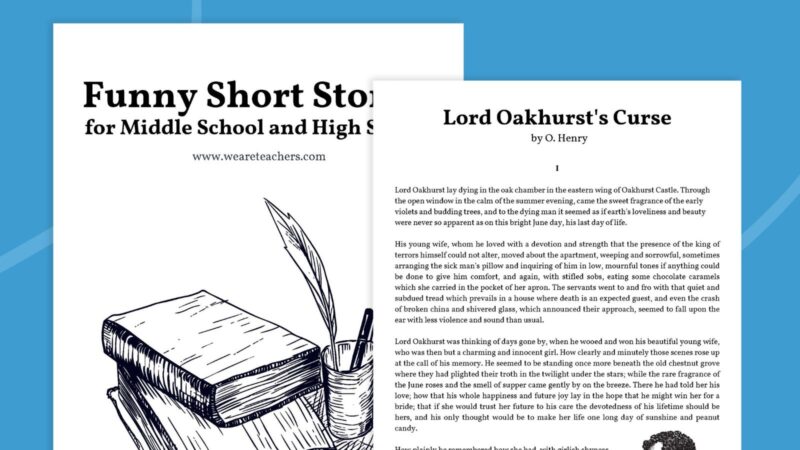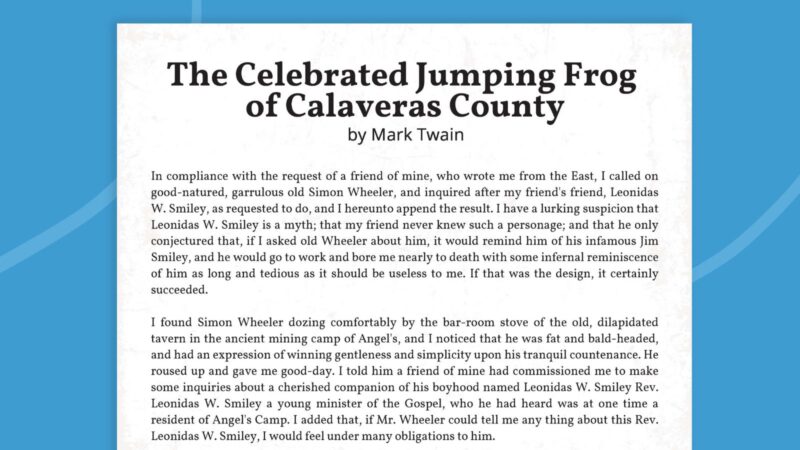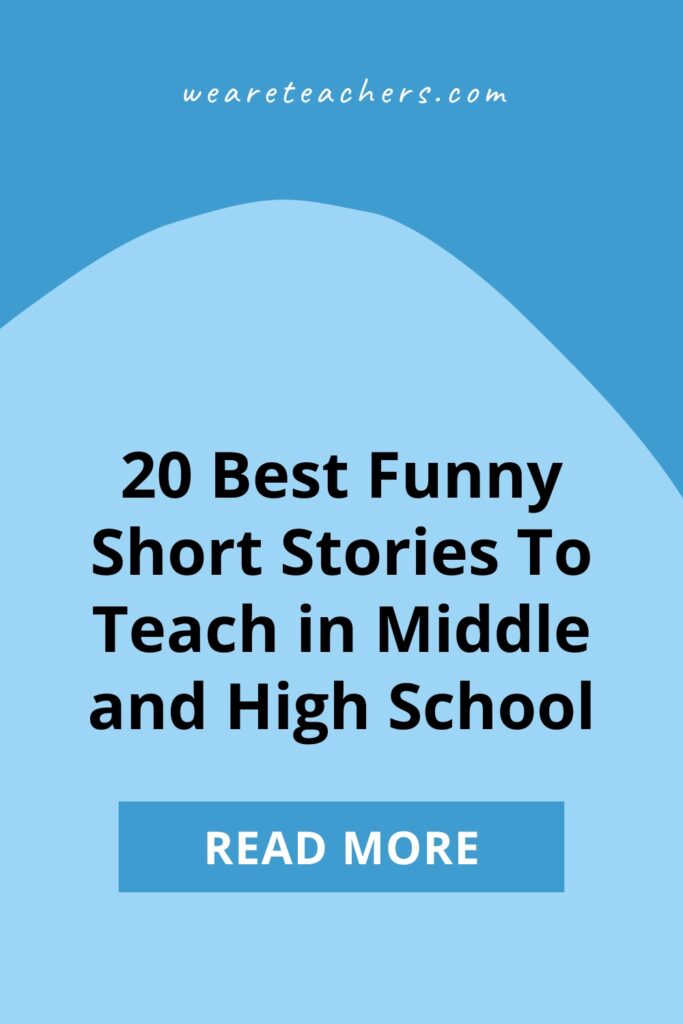At least once a year, one of my freshmen would ask me why everything we read in 9th grade English was so depressing. A quick look at our curriculum revealed they did have a point. Romeo and Juliet, Of Mice and Men, and short stories like “Lamb to the Slaughter” and “The Most Dangerous Game” all told tales of death and despair. While all are excellent, I began to wonder if I could find some different texts to add to the mix. It turns out, while scary short stories and dramatic short stories are easy to find, good funny short stories for middle and high school students are a bit trickier to track down.
With that in mind, here’s a list of funny short stories to use in your classroom when you want to bring a bit of humor to your lesson. Plus, fill out the form on this page to receive your own copy of a selection of the funny short stories below!
1. Ruthless by William DeMille
OK, this one might be a bit of a controversial addition to a list of funny short stories, but I’m including it anyway. There’s something darkly humorous in this little tale about a man who goes too far in a plot for revenge only to have it backfire on him in the worst possible way. Some of your students will feel bad for the protagonist while others will feel he deserves his fate. Regardless, your class will have a great discussion about it at the end.
In class: There are so many writing prompts you could use from this story, I don’t know where to begin. It could be used as the springboard for an argumentative writing unit, with students discussing whether or not the main character was justified in his actions. It could also be perfect for a discussion on characterization by asking students what can we learn about the main character and his wife through their actions and statements.
I love introducing students to science fiction, especially in the form of funny short stories. We really don’t use sci-fi enough in our English classes. In this story, two aliens discuss the bizarre new life-form they’ve discovered and try to figure out how it thinks and lives. Your students will laugh out loud when they discover that the aliens are talking about humans, and they’ll love figuring out the everyday activities and items the aliens just can’t seem to make sense of.
In class: This is perfect for introducing a new genre to students. After reading, ask students to craft their own science-fiction short story. As a class, brainstorm a list of activities and events that take place all the time that we think are totally normal. Then, ask students to write their version of an alien race trying to figure out a birthday party, after-school detention, or lunch in the school cafeteria.
3. Charles by Shirley Jackson
Written by the same woman who wrote the eerie short story “The Lottery,” this story is guaranteed to make students of all ages chuckle. The tale of the worst kindergarten student ever, as told by a classmate to his mother at the end of every school day, your students will love hearing all about Charles’ antics. The twist at the end of the tale will make students gasp and giggle.
In class: Perfect for lessons on irony, your students can debate whether Jackson’s funny short story demonstrates verbal, situational, or dramatic irony. I’ve also used this story to show students how an author can utilize dialogue as a method for developing characterization.
Like “Charles,” this is another classic, well-known story. An older woman takes a young man under her wing after he attempts to steal her purse. As they spend time together, she teaches him a valuable lesson about life. It’s perfect for upper-elementary and middle school students.
In class: This is one of those funny short stories that lends itself to lessons about dialogue, diction, theme, and characterization. It’s also a great text to use for practice discussions or Socratic seminars. Students could easily develop questions about the actions of the characters. They could consider how they would have responded in the same situation. And they could even reimagine the story as if it were written today.

While many students will have read “The Gift of the Magi,” this short story by the same author is much less well known. Lord Oakhurst is dying, his wife is grieving (or is she?), and a doctor arrives to try to help. Your students will be shocked and amused by this quick read.
In class: Indirect characterization leaps to the foreground in this funny short story as students can debate whether Lord Oakhurst’s wife is truly as sad as she says she is throughout the story. The story also makes use of flashbacks, making it great for introducing or reviewing that concept.
Satire is a tough genre for so many students. The popular satirical online news magazine The Onion comes to the rescue here with a hysterical piece that, while not a short story exactly, certainly tells a tale students will guffaw over. In the article, students learn the plight of a young man who almost received severe consequences for driving while under the influence. Some satirical pieces are almost too serious for students to see as satire, but this one does a great job of taking a serious subject and turning it on its head to make a point.
In class: This piece is perfect for students who aren’t ready to grapple with some of the more complex satirical pieces they’re often given in school. If your group isn’t quite ready for Swift’s A Modest Proposal, this is a great place to start. As an introduction to satire, pairing this piece with actual news reports of cases where privileged young people have received shockingly light sentences for serious crimes will definitely keep your students engaged (and enraged?).

This short story caper takes on the classic detective trope and mocks it mercilessly. Over-the-top costumes, mistaken identities, and a ridiculous reveal make this a truly funny short story to share with your students.
In class: I wish I still taught the mystery unit I taught for many years so that I could add this funny short story to the mix. This is a perfect piece to introduce satire. It mocks many of the most common elements of typical detective stories in a truly hilarious fashion.
Given her prominence in current popular culture, Margaret Atwood is an author our students should know. This short story about a fairy-tale writer receiving some “constructive criticism” on how to make their story more inclusive is sure to inspire reactions among your middle or high schoolers.
In class: This is a great short story to use when teaching the importance of how dialogue can impact tone. Additionally, it would be a great piece to bring to any discussion of whether or not students should read “old” stories that have language or ideas that are considered problematic today.
Definitely one for older students, this essay is a more complex text than many on this list. That being said, it’s a classic for a reason. Swift’s shocking and controversial (and highly satirical) suggestion that the plight of poor Irish peasants could be solved by having them sell their infants to rich British people to eat continues to resonate to this day. Give this to your high school students without any warning and get ready for some interesting reactions and responses.
In class: This piece is a staple in many high school lessons about satire, but I think it could also be used brilliantly in discussions about current political discourse. We struggle with recognizing satire in media today just as much as people did in Swift’s time. Additionally, the parallels between how the wealthy and elite in society look down at the less fortunate then and now could definitely make for some heavy, yet important, classroom discussions. Finally, it’s a perfect text for a lesson on tone—ask students to consider why Swift chose to write in a logical and emotionless voice about such a horrifying idea.
10. Joy by Anton Chekhov

The main character in this funny short story becomes famous. He rushes home to tell his family. Your students will love the reactions of his stunned family. They’ll also have plenty to say about the protagonist’s glorious new stardom.
In class: Perfect for units covering tragic heroes or characters who fall from grace, Chekhov’s work is a pretty searing commentary on the ideas surrounding what it means to be famous. Your students will have a great time making comparisons between the protagonist and various YouTube or TikTok stars of today.
Time to throw a curveball into the game. Have you heard of The Moth? It’s an organization with the mission to “promote the art and craft of storytelling and to honor and celebrate the diversity and commonality of human experience.” They have open-mic storytelling nights in different cities around the country where people just stand up and tell stories based on a preset theme. You can find lots of them on The Moth’s website and on YouTube. This one is about a man who has his identity stolen by a Domino’s Pizza employee. His mission to get revenge will have you and your students laughing out loud.
In class: Many of the stories do include a swear word or deal with adult themes, so be sure to preview the story first. I love the idea of sharing verbal storytelling with students of all ages, especially in the context of a unit on funny short stories. It’s great for reluctant readers and could make an awesome alternative assessment option.
Written by the same author who wrote “The Secret Life of Walter Mitty,” this story is also about an unhappy man who dreams of improving his life. The way he accomplishes this, however, is where the humor (and some shock!) comes in.
In class: Introducing students to more challenging text can always be a bit of a tough sell, so it’s nice to have a few short stories to warm students up to the idea. Students can practice transacting with text, asking questions about sections that confuse them, and working together to build comprehension.
Another curveball addition to this list of funny short stories! I love introducing my students to examples of real-life writing that is actually going on today. While many funny short stories on this list are from the early 1900s, this piece was written in 2020 and appeared in McSweeney’s Internet Tendency. The site features humorous pieces on a variety of timely topics. While many aren’t appropriate for school, others, like this one, are perfect examples of how people are still writing and creating today. In this piece, the personified “afternoon walk” explains to the person taking it that it can’t be everything the walker needs it to be.
In class: Best suited for older middle school and high school students, I would love to use this as a mentor text. Imagine the creative writing pieces students could come up with if asked to personify something in their lives.
Confession time: I hate ordering food by phone. It doesn’t matter if it’s healthy or not, or if I’m ordering for one person or 20. I hate it. I get flustered and almost always end up messing something up. Hence why this story, about a man who gets nervous in banks, spoke to me. Leacock’s description of the main character fumbling his way through opening a bank account had me laughing out loud.
In class: Finding characters from the past that students can relate to is tricky. I like the idea of asking students to free-write or discuss what situations make them feel anxious or uncomfortable. They could write down feelings, descriptions, and images. After reading this story, they could create their own humorous (or serious) stories about their own scenario.
I’ll admit this one blew my mind a bit, which is why I love the idea of sharing it with students. This short story, about a young man who invents a device that gathers together all the stories and novels ever written and then, using a mathematical formula, uses them to churn out new stories at lightning-fast speeds, was written in 1954. That’s right, Roald Dahl predicted ChatGPT and AI-generated stories decades ago. Watch your students’ minds be blown as they read this one.
In class: While Dahl may not have meant this short story to be considered science fiction, it certainly could fit into that genre. This piece would be perfect to pair with nonfiction articles about how AI is affecting creative fields as well as an argumentative unit in which students discuss whether or not these stories are better or worse than those written by human authors.
16. Growing Down by Shel Silverstein
Yes, it’s a poem. But it also tells a story, which makes it a great addition to this list of funny short stories. In this poem, we meet a grumpy old man who is always telling people to grow up. But one day, someone tells him to “grow down.” When he does, he discovers he likes it much more than growing up.
In class: This piece would be perfect for students who are struggling to grasp concepts like theme or characterization. There’s plenty of direct and indirect characterization throughout the poem, and the message is pretty obvious throughout. Additionally, Shel Silverstein’s voice is perfect for discussions about tone.
I chuckle, groan, and, yes, roll my eyes every time I reread this short story. It’s such an enjoyable little piece about a man who discovers “proof” that aliens exist and are hiding among us even though they can do shocking things with their bodies. It was always particularly well received by my students who didn’t really love figurative language and wished authors would just “say what they meant.”
In class: This story would be great as an introduction to dramatic irony. Part of what makes it so great is how we, as readers, groan each time the protagonist finds “proof” of alien life that we recognize as just an author’s use of imagery, hyperbole, and nonliteral language.
Another poem, I know. But it’s longish, so that counts, right? Your students might pick up on the parallels in theme between this fast-paced poem and the character of Mike Teavee from Charlie and the Chocolate Factory. Dahl was definitely not a fan of young people watching television instead of playing outside or reading books. One can only imagine what he would have thought about how much time our students spend looking at their phones today!
In class: I love the idea of asking students to write a modern version of this poem, substituting cell phones or TikTok in place of Dahl’s loathed television. It’s also a great piece for discussing tone, as Dahl’s feelings are made so abundantly clear throughout the text.
Jason Reynolds is a genius when it comes to creating characters who seem so real it feels like you’ve met them before. This short story about a young man getting ready for the first day of school will hit your students right in the feels. They’ll laugh, they’ll relate, and they’ll definitely identify with the struggles the protagonist experiences as he prepares to return to school.
In class: This short story would fit beautifully into any lesson about mood and point of view. The main character’s ability to express himself and his feelings is so enjoyable to read. It would also be a great study on how allusions can date a text. While our students will understand immediately why the character cares so much about his sneakers remaining perfectly white, will people in the future? It would be interesting to pair this piece with an older text and compare the allusions of each.

We sometimes shy away from challenging texts when looking for new stories to share with our students, but Twain is an excellent author to turn to when you want to explore how to tackle tough reads. There’s definitely something to be said for slowing down and really focusing on how an author uses words to tell a story. This one, about a man listening to an incredibly long-winded tale about a frog-jumping contest gone wrong, will have your students chuckling by the end.
In class: This story would be ideal for introducing students to the tall-tale genre, a unique American storytelling tradition that celebrates colorful characters, improbable events, and hyperbole. It also would be a perfect mentor text when teaching regional dialects or how dialogue affects mood and tone.
We’re headed back to O. Henry for this one because he was just so good at funny short stories. Your students will get a kick out of seeing a humorous Western romance unfold between Joséfa, a brave and headstrong ranch owner, and Ripley Givens, a cowboy trying to impress her with his bravery. They’ll like it even more when they get to the part with the puma and O. Henry’s telltale surprise ending.
In class: Like many other stories in this list, this is a perfect short story for a lesson on irony. I like it more, however, for how it turns themes like pride and our perception of others on their heads. Have your students do a pre-writing exercise sharing their background knowledge of Westerns, damsels in distress, and cowboys, and then have them compare their previous perceptions with the reality presented in the story for a fun and meaningful discussion.
Get my free printable funny short stories
Fill out the form on this page to snag your printable for free!
Looking for more short stories to share with your class? Check out 78 Great Short Stories To Teach in Middle School.
For more articles like this, be sure to subscribe to our newsletters to find out when they’re posted!



Recent Comments